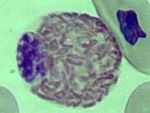Difference between revisions of "Heterophils"
| Line 1: | Line 1: | ||
| + | {{OpenPagesTop}} | ||
==Introduction== | ==Introduction== | ||
[[Image:Heterophil.jpg|150px|thumb|right|'''Heterophil''' (Copyright © RVC)]] | [[Image:Heterophil.jpg|150px|thumb|right|'''Heterophil''' (Copyright © RVC)]] | ||
| Line 56: | Line 57: | ||
{{review}} | {{review}} | ||
| + | |||
| + | {{OpenPages}} | ||
| + | |||
[[Category:Expert Review - Bird]] | [[Category:Expert Review - Bird]] | ||
[[Category:Blood Cells]] | [[Category:Blood Cells]] | ||
[[Category:Lizard_and_Snake_Glossary]] | [[Category:Lizard_and_Snake_Glossary]] | ||
[[Category:Expert Review - Exotics]] | [[Category:Expert Review - Exotics]] | ||
Revision as of 14:28, 20 July 2012
Introduction
Heterophils are the most abundant granulocyte in most avian species and occur alongside lymphocytes, monocytes, eosinophils and basophils in avian blood. These cells are also found in some reptile and mammalian species.
Development
Heterophils have a similar development to other granulocytes; this process is called granulopoiesis.
Appearance
The cytoplasm of normal heterophils appears colourless and contains eosinophilic granules (dark orange to brown-red) with Romanowsky stains. The cytoplasmic granules are elongated (rod or spiculated shape) but they may appear oval to round in some species.
The granules frequently have a distinct central body that appears to be refractile. The granules may be affected by the staining process and appear atypical.
The nucleus of mature heterophils is lobed (usually two to three) with coarse, clumped chromatin that stains purple. The nucleus is often partially hidden by the cytoplasmic granules.
Function
Heterophils are functionally equivalent to neutrophils. They actively participate in inflammatory lesions and are phagocytic.
The cytoplasmic granules of heterophils contain lysozyme and proteins needed for bactericidal activity, although chicken heterophils lack peroxydase activity.
Changes
Immature Heterophils
These have increased cytoplasmic basophilia, non-segmented nuclei and immature granules compared with normal, mature heterophils.
The immature heterocytes most frequently encountered in blood are myelocytes and metamyelocytes. Myelocytes are larger than mature heterophils and they have a blue cytoplasm as well as secondary, rod-shaped granules and a round to oval non-segmented nucleus. Metamyelocytes resemble myelocytes except that the nucleus is indented and the rod-shaped granules occupy more than half the cytoplasmic space.
Band heterophils resemble mature heterophils, except that the nucleus is not lobed. The nucleus is often hidden behind the cytoplasmic granules, and it can be difficult to identify a band heterophil. Special stains can help with this.
Toxic Heterophils
Heterophils exhibit toxic changes in response to severe systemic illness.
These changes are quantified as to the number of toxic cells and the severity of the toxicity.
Toxic heterophils have increased cytoplasmic basophilia, vacuolisation, abnormal granulation (degranulation, deeply basophilic granules, coalescing granules) and degeneration of the cell nucleus.
The degree of toxicity can be rated on a scale of 1+ to 4+:
- 1+ toxicity: heterophils exhibit increased cytoplasmic basophilia
- 2+ toxicity: heterophils have deeper cytoplasmic basophilia and partial degranulation
- 3+ toxicity: heterophils have deep cytoplasmic basophilia, moderate degranulation, abnormal granules and cytoplasmic vacuolisation
- 4+ toxicity: heterophils have deep cytoplasmic basophilia, moderate to marked degranulation with abnormal granules, cytoplasmic vacuolisation and karyorrhexis or karyolysis.
The number of toxic heterophils is graded as few (5-10%), moderate (11-30%) or marked (>30%).
| Heterophils Learning Resources | |
|---|---|
 Test your knowledge using flashcard type questions |
Avian Medicine Q&A 21 Reptiles and Amphibians Q&A 11 |
References
Thrall, M. (2004) Veterinary haematology and clinical chemistry Wiley-Blackwell
Fudge, A. (2000) Laboratory medicine: avian and exotic pets Elsevier Health Sciences
Feldman, B. (2000) Schalm's Veterinary haematology Wiley-Blackwell
Frye, FL & Williams, DL (1995) Self-Assessment Colour Review - Reptiles & Amphibians Manson
| This article has been peer reviewed but is awaiting expert review. If you would like to help with this, please see more information about expert reviewing. |
Error in widget FBRecommend: unable to write file /var/www/wikivet.net/extensions/Widgets/compiled_templates/wrt6935bed15b5088_27949760 Error in widget google+: unable to write file /var/www/wikivet.net/extensions/Widgets/compiled_templates/wrt6935bed1699c15_80819061 Error in widget TwitterTweet: unable to write file /var/www/wikivet.net/extensions/Widgets/compiled_templates/wrt6935bed16ed795_48602095
|
| WikiVet® Introduction - Help WikiVet - Report a Problem |
